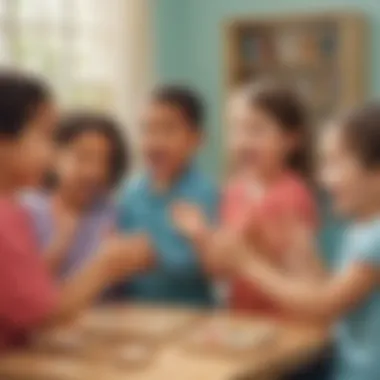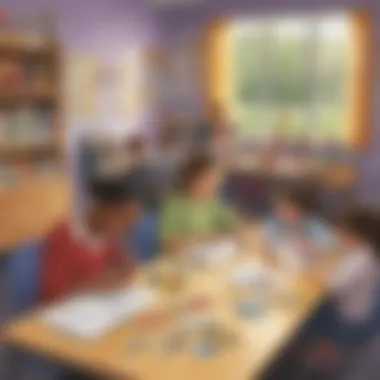Understanding Syllables: A Pathway to Enhanced Literacy Skills


Intro
Syllables are often overlooked, yet they play a crucial role in language and literacy development. Recognizing their value can help children advance their reading and writing skills. Language is structured on syllables, which act as the building blocks of words. Understanding syllables enhances phonemic awareness, bridging the gap between spoken and written language.
With this foundation in mind, the following sections of the article unfold various strategies, activities, and educational tools to engage children in learning about syllables. A blend of interactive games, DIY projects, and effective tips will support not only parents and educators but also stimulate children's cognitive growth.
Interactive Learning Games
Interactive learning games are a powerful way for children to grasp syllabic concepts in an enjoyable manner. Games designed around language skills help foster engagement and retention. Think about how fun it is for kids to play while they learn, subtely gaining awareness of syllables.
Popular Games
- Syllable Word Toss: A game where children toss a ball back and forth, saying a word while scoring points based on syllables. It’s fast-paced and free from pressure.
- Beat the Rhyme: Players create rhymes using specific syllable counts. This often sparks creativity and can be played individually or in groups.
Description of top educational games
Each game focuses on making syllables tangible. For instance, in Syllable Word Toss, players also physically engage, which can connect the concept to a kinesthetic mode of learning. Other games, like Word Clamor, involve cooperative dialogue as players build words, fostering social skills alongside literacy-academic skills.
Benefits of playing educational games for kids' cognitive development
Games like these develop critical thinking skills. They also enhance memory. Most importantly, play nurtures an enjoyable environment that sparks curiosity about language. Games can be adapted for various skill levels, allowing children to tackle challenges comfortably.
Game Reviews
In-depth reviews of selected educational games
- Syllable Word Toss: This game not only teaches syllables but also promotes teamwork. The physical aspects of tossing encourage movement, beneficial for diversified learning styles.
- Beat the Rhyme: Highlights the importance of rhythm and language flow and offers a robust framework for literary skills.
Comparison of gameplay and learning outcomes
While both games implement foundational syllable knowledge, Syllable Word Toss leans more towards physical interaction and teamwork, while Beat the Rhyme encourages independent thought and creativity through poetry.
Tips and Tricks
Practical tips can amplify children’s learning experiences when it comes to syllables.
Practical tips for parents and educators to enhance children's learning journey
- Integrate sports and games into syllable learning. It can energize a standard lesson.
- Encourage reciting trips while counting syllables. Repetitive engagement solidifies learning.
Strategies for making learning fun and engaging
Games are effective, but also try rhythmic clapping or singing to similar syllable patterns. Create environments that feel less like school and more like a community gathering. Keeping things fresh can keep kids excited about learning.
Creative DIY Projects
Hand-on experiences enhance the learning process significantly. They enable children to connect what they hear to what they see and feel. Involving children in artistic projects promotes cognitive and motor skills.
Step-by-Step Guides
Follow simple instructions to help children see and produce syllables materially.
- Syllable Fish Craft: Use paper plates. Cut them in half, then let children decorate them. Write down words on the body that feature the same number of syllables. This illustrates the concept visually and interactively.
Craft Ideas
- Syllable Collage: Collect images from magazines that correspond to different syllables. Glue items together from one-syllable words, two-syllable or longer, leading up to complex words as their experience expands.
- Create a syllable book using everyday objects to photograph. Children write down one-syllable, two-syllable, three-syllable words corresponding to each image, promoting classifications.
Children develop uniquely when they interact with ideas physically while linking syllabic knowledge to their everyday reality. These strategies position children to grow as confident learners while seamlessly engaging with the world of language.


Prelims to Syllables
Syllables play a crucial role in language and literacy development. Understanding their structure aids in word formation and pronunciation. Grasping this concept is key for effective communication. Many overlook the importance of syllables when focusing on reading strategies or phonics. However, awareness of syllables accelerates literacy skills and enhances phonic awareness.
The Definition of a Syllable
A syllable is essentially a unit of spoken language. It consists of a vowel sound, with or without surrounding consonant sounds. Simplistically, each syllable is a beat in a word. When we say the word
Components of a Syllable
Syllables are key building blocks of language. In this part of the article, we will look at their various components. Understanding these parts helps in improving literacy skills. Each component plays a distinct role in how words are formed and pronounced.
Onset, Nucleus, and Coda Explained
A syllable has three main parts: onset, nucleus, and coda. The onset is the initial consonant sound of a syllable. For example, in the word "cat", the letter "c" is the onset. The nucleus is typically a vowel sound. In "cat", the vowel "a" makes up the nucleus. This component is essential for the syllable's sound. The coda follows the nucleus and consists of any final consonant sounds. In the word "cat", the final letter "t" is the coda. Together, these elements create a complete syllable, contributing to our understanding and pronunciation of words. Knowing these components enhances phonemic awareness, fostering better reading abilities.
Types of Syllables
A few primary types of syllables exist, which vary based on their structure. Familiarity with these categories is crucial for both educators and learners. Here are the main types:
- Open syllables end with a vowel, often resulting in a long vowel sound. For instance, in the word "be", the entire syllable is open.
- Closed syllables conclude with a consonant that wraps around the vowel, creating a short vowel sound. The word "cat" serves as an example.
- Silent E syllables include a silent 'e' at the end that often modifies the preceding vowel sound. In the word "cake," the final 'e' changes the vowel from a short to a long sound.
- Vowel team syllables contain two vowels together. They may create a distinct sound combination like in the word "team".
- Consonant blend syllables feature two or more consonants before the vowel like in "stop". Each consonant letter blends together to create a singular sound.
Recognizing these types enables educators to tailor their teaching methods based on individual learning needs, thereby enhancing literacy skills over the long term.
Types of Syllable Structures
Understanding the structures of syllables is essential in building a strong literacy foundation for children. Syllable structures help educators and parents identify how different elements of syllables function together. Learning how to effectively segment and blend syllable patterns improves young learners' reading proficiency. This section looks in detail at open syllables, closed syllables, vowel teams, consonant blends, and single versus multi-syllable words.
Open and Closed Syllables
Open and closed syllables are fundamental concepts in understanding how words are constructed. An open syllable ends with a vowel sound, allowing the vowel to be pronounced with its long sound, such as in the word 'go'. On the other hand, a closed syllable ends with a consonant, creating a short vowel sound, like in the word 'cat'.
Knowing the distinction between open and closed syllables helps in phonetic awareness. When children learn these types, they can decode words more efficiently. Effective instruction at an early age sets the groundwork for lifelong reading skills.
Key characteristics include:
- Observation of Vowel Sounds: Children must recognize how the final consonant impacts the vowel sound.
- Blending Skills: Open syllables typically blend differently than closed ones. Direct instruction reinforces these specific patterns.
Vowel Teams and Consonant Blends
Vowel teams and consonant blends introduce complexity to syllable reading. Vowel teams occur when two vowels are together and produce one sound, such as the 'ea' in 'team'. Consonant blends occur when two or more consonants are linked but maintain their individual sounds, such as in ‘bl’ as in ‘blend’.
Teaching these concepts can be effective through repetitive exposure and interactive methods. Consider solidifying this knowledge through real example words that contain these blends or teams.
- Examples of Vowel Teams:
- Examples of Consonant Blends:
- ai as in aid
- ou as in cloud
- sn like in snap
- tr in train
Overall, focusing on both vowel teams and consonant blends enhances children's comprehension of syllabic structure in reading.
Single and Multi-Syllable Words
Understanding single and multi-syllable words is vital for fluent reading and communication. Single syllable words like 'cat' or 'dog' are straightforward and typically easier for children to learn. However, multi-syllable words, such as 'butterfly' or 'information', require more advanced phonemic awareness.
Children must grasp the significance of syllable count when reading and spelling. Determining the number of syllables in a word acclaimed as elementary in language acquisition proves to aid in effective processing. Helpful aspects in teaching this include:
- Solving or clapping out syllables to foster awareness.
- Encouraging them to break multi-syllable words into manageable singles to master.
As students build their skills in recognizing these structures, their vocabularies expand alongside phonetic understanding.


Phonemic Awareness and Syllables
Phonemic awareness is often considered a cornerstone of literacy development. It promotes a child's ability to distinguish and manipulate individual sounds in spoken language. Syllables play a significant role in this process. Recognizing syllables aids phoneme segmentation and decoding. Such understanding encourages confident reading skills, allowing for more effortless word recognition.
The Link Between Syllables and Phoneme Recognition
Syllables and phonemes coexist within the structure of words. A syllable often functions as a unit of rhythm and beats in spoken communication. Phoneme recognition itself refers to the ability to hear, identify, and use the smallest sound units in language. When children learn to recognize syllables, they gain a greater sense of awareness concerning phoneme manipulation.
This awareness leads to several advantages:
- Enhanced Listening Skills: Children become more skilled at identifying sounds when they hear them.
- Better Phoneme Segmentation: Understanding how syllables work allows learners to break down words into manageable parts.
- Increased Vocabulary Understanding: Familiarity with syllables facilitates understanding unfamiliar words.
Children may practice this link through various activities, such as clapping or tapping when they pronounce words. This kind of physical embodiment strengthens their ability to process sounds.
Building Blocks of Reading Proficiency
A strong foundation in syllabic understanding lays essential building blocks for reading. Children who grasp syllables can decode words more reliably. This step dramatically ramps up reading fluency.
Moreover, syllables help learners navigate different types of word structures. Understanding syllables leads to skillful reading because they recognize patterns in the language. When syllable education emphasizes:
- Breaking Down Complex Words: Children become comfortable tackling longer words easily.
- Improving Spelling Skills: Syllabic awareness transfers skills into spelling and writing.
As a result, phonemic awareness and syllable recognition are intertwined. Mastery in these areas not only strengthens literacy but prepares children for engaging with diverse texts later on.
In summary, phonemic awareness and syllables are key components in developing effective reading habits, ensuring holistic literacy growth and fostering long-term educational success.
Teaching Strategies for Syllables
Teaching strategies for syllables are essential in nurturing literacy skills among young learners. Understanding syllables is foundational to effective reading and writing. When educators and parents introduce syllables systematically, it promotes phonemic awareness. This increased awareness makes it easier for children to decode words, identify sounds, and improves spelling skills.
Additionally, structured teachings tailored for young learners can help them build confidence in their reading capabilities. Early success can lead to a positive attitude toward literature and a lifelong interest in reading. Also, it is necessary to recognize that every child learns at a different pace. Thus, customizing strategies to fit individual needs while making learning fun can significantly enhance retention.
Effective Approaches for Young Learners
Effective approaches for teaching syllables should incorporate diverse methods to engage young learners. One way is through hands-on activities which can provide tactile learning experiences.
Considerations for effective strategies include:
- Modeling Syllable Clapping: This method involves clapping hands to count the syllables in words. Say a word slowly, emphasizing each syllable while clapping. It's an interactive approach that encourages participation.
- Visuals: Use pictures or flashcards to represent words and their corresponding syllable count. Associating visuals with sounds can enhance memory retention.
- Syllable Sorting: Introduce sorting activities where children classify words with the same syllable count. For example, one-syllable words might go in one pile, while two-syllable words are in another.
- Games: Games encourage learning in an enjoyable manner. Incorporate syllable-related games such as bingo or memory matching, where kids identify and match words based on syllable patterns.
These methods foster a comprehensive environment where learners can explore syllables in various contexts.
Using Rhymes and Patterns
Utilizing rhymes and patterns is an effective teaching tool in syllable education. Rhymes naturally draw attention to the sounds in words, making the discovery process more enjoyable for children.
Some strategies to include are:
- Nursery Rhymes: Integrate traditional nursery rhymes into lessons. Children can identify syllables in familiar rhymes. When they recite these rhymes, they often feel more relaxed and engaged.
- Creating Patterns: Encourage children to create poems or simple songs that have repetitive syllable structures. Repetition can aid in memory and internalization of concepts, solidifying their understanding.
- Interactive Activities: Involve learners in creating rhythmic patterns using clapping or musical instruments for each syllable of a word. This involvement enhances engagement and learning retention.
Using rhymes and patterns not only makes learning varied and fun but also promotes the understanding of syllable structures through a playful lens, reinforcing essential literacy foundations.
Activities to Enhance Syllabic Understanding
Understanding syllables is crucial for building literacy skills. It goes beyond identifying single sounds; it includes recognizing how syllables function in word formation. Engaging activities built around syllables can significantly aid comprehension and application. Such activities foster deeper phonemic awareness, boost reading proficiency, and make the learning process enjoyable for children. Through these practices, essential skills such as word segmentation, blending, and manipulation become more attainable. Not only do they promote learning in a playful manner, but they also help form lasting associations with language, leading to a more robust reading capability.
Interactive Games and Exercises
Interactive games and exercises serve as dynamic tools in solidifying syllabic understanding. Children are especially receptive to learning through play. Using board games, card games, and computer-based activities can create fun learning environments.
Benefits of Interactive Games


- Engagement: Games naturally spark interest and motivate children to participate.
- Retention: Repeating syllabic concepts through games reinforces memory retention.
- Social Skills: Many games encourage collaboration, promoting teamwork and interpersonal abilities.
Some practical examples include:
- Syllable Sort: Create flashcards with different syllables. Invite children to organize cards into categories based on the number of syllables.
- Syllable Clapping: Play a rhythm game by saying a word and asking children to clap the syllables. This physical activity helps them internalize syllable division.
- Matching Games: Design a matching card game where kids find pairs of words sharing the same syllable counts.
DIY Projects for Syllable Practice
Do-it-yourself projects give learners the chance to create tangible learning materials. Engaging in DIY activities encourages creativity while promoting learning. Such endeavors facilitate understanding through hands-on participation.
Advantages of DIY Projects
- Active Learning: Crafting materials promotes involvement and requires children to think critically about their creation.
- Customization: Children can personalize projects, which heightens their interest and investment.
- Practical Application: Actual crafting helps link theory to real-world understanding.
Project ideas for syllable reinforcement include:
- Syllable Crafts: Use paper circles and let children create visually appealing representations of different words. Each part can symbolize individual syllables while they put together the final product.
- Syllable Booklets: Encourage kids to compile a small booklet where they draw and write different words according to their syllables. This invites context into understanding.
- Interactive Charts: Help them create a colorful chart on syllable types in everyday words. This method iterates concepts and employs their artistic side.
By engaging in both interactive games and hands-on DIY projects, children progress towards a more substantial command of syllables. Thus, these activities function to weave foundational elements of reading proficiency seamlessly within their creative framework.
Digital Resources and Tools
Digital resources can significantly enhance the learning experience around syllables. Technology has changed how children learn and engage with concepts related to literacy. This article section focuses on various types of digital tools and platforms that can make the understanding of syllabic structures not just easy but also enjoyable for young learners.
The integration of digital resources offers notable benefits. Firstly, these tools provide interactivity, which can maintain the engagement of learners better than traditional methods. Young learners often respond well to visual and movement-based activities. Furthermore, technology affords flexibility in education. Parents and teachers can access a wide variety of resources tailored for different learning styles. These resources strengthen children's phonemic awareness in engaging settings, thus enhancing literacy skills.
Before choosing a digital resource, consider the age appropriateness and educational value. Not all apps or platforms will cater to every learning need. It's crucial to select tools that offer sound educational frameworks and address syllable learning in a structured way. Quality of content is important as well. Parents and times dos or educators should review whether the resource encourages active participation.
Apps to Aid Syllable Learning
A number of apps stand out in their capability to support syllable learning. For instance, Endless Alphabet not only introduces children to vocabulary but also reinforces syllabic breakdown by illustrating the connection between letters and sounds. It promotes both phonemic awareness and an understanding of syllables through games and activities consisting of visual and punctuated sounds.
Another commendable option is Syllable Splitting, an app that focuses specifically on auditory and visual identification of syllables in words. By creating a fun and interactive environment, it enables children to learn heart of syllables while playing. These apps often include features that allow children to practice at their own pace.
Phonics Genius also deserves mention as it provides a wide range of phonics-based learning games that include syllable recognition. More importantly, it features immediate feedback, ensuring students can comprehend errors on the go. Through practice activities, children hear and see how syllables work within different words, solidifying their understanding.
Online Platforms for Engaging Content
Beyond apps, several online platforms provide rich content for practicing syllable recognition. Websites such as Starfall offer approachable lessons targeting syllables that appeal to young learners. With an array of interactive games, children learn syllable division, sound recognition, and more, all while remaining engaged with stimulating graphics and empowering narratives.
Another valuable platform is PBS Kids, which not only presents educational content but also implements syllable activities embedded within various animated shows. Recent games involve matching sounds, piecing together words, and other activities designed so learners are motivated to play while they learn.
Thanh, platforms like Teachers Pay Teachers present a treasure trove of printable resources spanning syllable worksheets, games and classroom materials. At times, educators provide information and tips on using these worksheets effectively to promote syllabic learning.
Engaging these digital tools bridges the gap between auditory and visual learning and creates a holistic learning environment conducive to improving literacy skills. By capitalizing on the unique offerings of these resources, parents and educators can provide layered support for children's mastery of syllables.
Culmination
Understanding syllables is crucial to developing literacy skills in children. This article highlights the structural role of syllables in language, shaping not only spoken but also written communication. By breaking down words into manageable parts, syllables make learning to read simpler for young learners.
Recap of Syllable Importance
Syllables serve as building blocks of spoken language. Each syllable contains a core vowel sound, surrounded by consonants, which enhances phonemic awareness. Recognizing syllable patterns allows children to decode unfamiliar words more effectively. This skill fosters spelling and pronunciation abilities. Therefore, a strong grasp of syllables empowers children to navigate reading materials with greater confidence.
Key points regarding the importance of syllables include:
- Phonemic Awareness: The connection between syllables and broader sound awareness is significant for emerging readers.
- Word Structure: Understanding how syllables form words helps with vocabulary expansion.
- Reading Fluency: Children quickly identify syllabic patterns which speeds up the reading process.
Encouraging Lifelong Learning in Literacy
A solid foundation in syllable recognition sets the stage for ongoing literacy development. Lifelong literacy is not limited to decoding words; it extends to comprehending various texts. In an ever-changing world, encouraging a love for reading early on equips future generations with essential critical thinking skills.
Consider these methods to foster a platform for continuous learning:
- Reading Aloud: Share books that emphasize rhythmic patterns to reinforce syllables.
- Engaging Activities: Games focusing on syllable identification can create fun learning experiences.
- Discussions Around Words: Encourage conversations about the structure and meaning of words, enhancing engagement.
By nurturing an environment where syllables are recognized and valued, parents and educators stimulate a lifelong passion for reading and literacy, benefitting not only academics but everyday life and learning pursuits.















